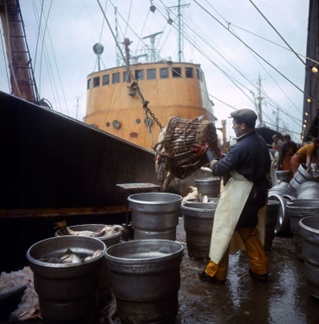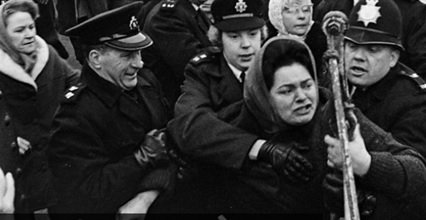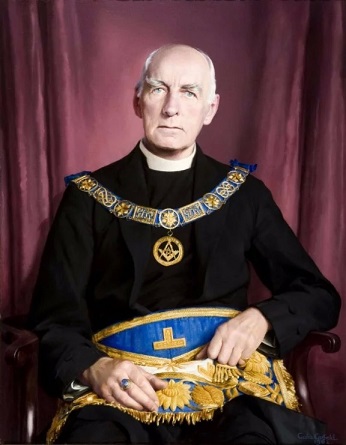While there is not a lot to report regarding the Minerva Lodge in the sixties, Hull was changing, and there can perhaps be no better authority than Neil Armstrong, who writes as follows.
After a decade of post-war austerity, the youth of 1960s England were ready to party, and party they did. Go-go boots, mini-skirts, and mind-blowing outfits in groovy colours would be seen in the streets of London. Twiggy, Mary Quant, and Jean Shrimpton became everyday icons of style. The Profumo Affair made Christine Keeler a notorious tabloid name. 1966 saw the legendary World Cup win of England over Germany.
 However, the swinging 60’s in Hull took on a very different meaning from London’s Carnaby Street. Lots of men called 'Bobbers' worked on St. Andrews dock, unloading fish from the deep-sea trawlers via baskets onboard the ship and then swung onto the dockside. Bobbers got their name because lots of these baskets full of fish would be swinging to and from the trawlers and the men had to constantly 'bob' out of the way to avoid being knocked over.
However, the swinging 60’s in Hull took on a very different meaning from London’s Carnaby Street. Lots of men called 'Bobbers' worked on St. Andrews dock, unloading fish from the deep-sea trawlers via baskets onboard the ship and then swung onto the dockside. Bobbers got their name because lots of these baskets full of fish would be swinging to and from the trawlers and the men had to constantly 'bob' out of the way to avoid being knocked over.
With a fleet of around 350 trawlers, St Andrew's Dock was a busy, bustling place. The trawlermen, dock and smoke house workers all tended to live down Hessle Road, which had a real 'community spirit'. People helped and cared for their neighbours.
Hull’s trawlermen were known as 'three-day millionaires'. This was because they were only home for about three days at a time, before they went off on another fishing trip. On a profitable trip they would get their wages and walk home feeling like a millionaire! Life at sea was extremely hard and dangerous, so when ashore the trawlermen enjoyed life to the full.
 Those Arctic waters were a phenomenally dangerous place and in 1968, three trawlers from Hull sank within a few weeks of each other. Only one man survived, 58 men perished. The ‘St Romanus’ was the first trawler to be lost on the 18 January. The second trawler in the disaster was the ‘Kingston Peridot’, which was lost on the 26 January. The ‘Ross Cleveland’ was the third trawler to be involved in the tragedy. It was lost on the 4 February,
Those Arctic waters were a phenomenally dangerous place and in 1968, three trawlers from Hull sank within a few weeks of each other. Only one man survived, 58 men perished. The ‘St Romanus’ was the first trawler to be lost on the 18 January. The second trawler in the disaster was the ‘Kingston Peridot’, which was lost on the 26 January. The ‘Ross Cleveland’ was the third trawler to be involved in the tragedy. It was lost on the 4 February,
A campaign for better safety at sea was launched by Lillian Bilocca, Christine Jensen, Mary Denness, and Yvonne Blenkinsop; wives, sisters, and daughters of trawlermen. Lillian earned the nickname of 'Big Lil' during her campaign becoming a local folk hero.
 Known as the ‘Headscarf Revolutionaries’ they gathered a petition calling for reform and also led a delegation to Parliament. This campaign led to government intervention in safety standards in the trawling industry and was estimated to have saved thousands of lives. It is hard to believe now that Hull was then one of the world’s biggest fishing ports. Yet within just over a decade, that most dangerous of professions, Arctic deep-sea trawling, would become a forgotten age.
Known as the ‘Headscarf Revolutionaries’ they gathered a petition calling for reform and also led a delegation to Parliament. This campaign led to government intervention in safety standards in the trawling industry and was estimated to have saved thousands of lives. It is hard to believe now that Hull was then one of the world’s biggest fishing ports. Yet within just over a decade, that most dangerous of professions, Arctic deep-sea trawling, would become a forgotten age.
--ooOoo--
In July 1963 letters received from the Board of Management regarding the completion of a "Rehabilitation Unit" to the Royal Masonic Hospital persuaded the Minerva Lodge to contribute. A resolution that annual Lodge subscriptions be increased from £5/5/- to £6/10/- was made in November, and that the Building Fund be responsible for the payment of all expenses connected with the maintenance of the Building and the provision of services.
In 1965 R W Bro Bishop Herbert's remarks regarding the Obligation Penalties were discussed, for which some background is needed:
 On 10th June 1964, before the close of business of the Quarterly Communication in Grand Lodge, the MW Grand Master invited RW Bishop Herbert, Provincial Grand Master of Norfolk to speak about the Masonic Penalties. Bishop Herbert outlined the ethical and religious problems of the penalties which the Candidate was required to repeat, suggesting that a small variation in wording would make it clear that the physical penalties were symbolic and never actually performed. A discussion was agreed upon for December.
On 10th June 1964, before the close of business of the Quarterly Communication in Grand Lodge, the MW Grand Master invited RW Bishop Herbert, Provincial Grand Master of Norfolk to speak about the Masonic Penalties. Bishop Herbert outlined the ethical and religious problems of the penalties which the Candidate was required to repeat, suggesting that a small variation in wording would make it clear that the physical penalties were symbolic and never actually performed. A discussion was agreed upon for December.
Bishop Herbert developed his case, emphasising that the proposed changes of a few words would move a serious moral problem, leaving the penelties in the Obligation, but effectively removing them from "what the Candidate so solemny swears to".
The debate continued for over two hours and it was suggested that the Board of General Purposes might appoint a committee, but the President of the Board of General Purposes had no authority over ritual. The MWGM put forward the resolution for change and it was overwhelmingly accepted.
Over the next weeks popular versions of the Ritual, e.g. Taylor's, Universal and West End published "authorised workings".
Minerva Lodge discussed this in July 1965 and the considered options examined. Worshipful Brother Stephenson, opposed to any change, was persuasive in closing the discussion; a ballot was taken which showed a majority in favour of "no change in the Ritual."
 In February 1968 a compulsary purchase order was served on the Lodge premises in connection with the Old Town Development Scheme. A plan was on view in the Guildhall indicating that the Lodge premises were due for demolition if the Corperation were successful in gaining approval of the Ministry. The Minerva Lodge organised a "Fighting Fund". "Our defence," Austin wrote, "was placed in the hands of Worshipful Brother C E Taylor (Estate Agent and Valuer), Brother J Stow (Solicitor) and Brother J Konrad (Architect). These were difficult times.
In February 1968 a compulsary purchase order was served on the Lodge premises in connection with the Old Town Development Scheme. A plan was on view in the Guildhall indicating that the Lodge premises were due for demolition if the Corperation were successful in gaining approval of the Ministry. The Minerva Lodge organised a "Fighting Fund". "Our defence," Austin wrote, "was placed in the hands of Worshipful Brother C E Taylor (Estate Agent and Valuer), Brother J Stow (Solicitor) and Brother J Konrad (Architect). These were difficult times.
The 1960s saw the reputation of both Freemasons and police officers being brought into disrepute when the Times revealed evidence of corruption in the Metropolitan Police's CID unit and noted that some London detectives were Freemasons. Such is the power of the Press, this continued until the mid-1990s, but led eventually to the increased accountability of the police. In the meantime Freemasonry was working gradually towards a more open attitude.
--ooOoo--

